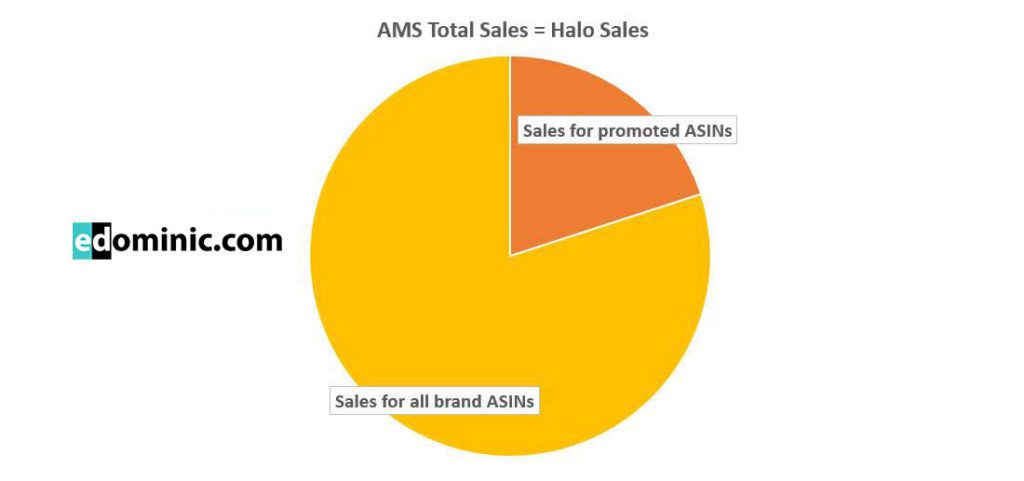The concept of halo sales in AMS means that the estimated total sales that you are seeing in your campaigns, are sales that the ads have influenced across all your brand products, not only the ones that you are promoting. This concept is crucial to understand when analysing the performances of your AMS campaigns.

AMS sales = Halo sales = sales for promoted ASINs + sales for all ASINs belonging to the brand (after user clicks on ad)
Halo sales in AMS: example
To understand better how this works, let’s take the following example:
Your brand is in the PC category and you are selling Laptops, PCs, and Tablets. You have AMS campaigns running only for laptops. A user clicks on one of your AMS campaigns that you are running > he/she ends up purchasing a tablet that you aren’t promoting. The sale will still be attributed to the Laptops’ campaign, as the tablet that he purchased is part of your own brand.
Sales are attributed to a campaign only if a user clicked on the ad before the purchase was made. Read more about the Sales Attribution Model in AMS.
So, when an advertiser creates an AMS campaign to promote one or more ASINs, AMS expands those ASINs to others within that brand’s subcategory, category, and General Line (GL). When a customer clicks on the ad and purchases a product within that brand’s subcategory, category, or GL, the campaign gets sales’ credit for that order, as it helped the customer discover the brand.
Are AMS estimated total sales real sales?
Yes, and No.
No, because the sales are not for the products that you are promoting, but for all the products belonging to your brand.
Yes, because even if they are halo sales, they were still influenced by the campaigns that you are running (i.e. a user had to click on one of your campaigns for the sale to be attributed to your ad). This is the old sales’ attribution principle that advertising is based on: you are promoting one of your products to create brand awareness that will help increase sales for all your products.
Is there a way to see real sales vs halo sales in AMS?
At this moment, Amazon doesn’t provide this information. They will probably keep the halo sales practice going. If they split the sales, they risk that advertisers will put less money onto AMS, as they will see the real sales that the campaigns are generating – these would be lower than the current metrics.
Conclusion on Halo sales on AMS
The total sales and Units sold data from the AMS campaigns can be deceptive, as they are not only sales for the products that you are advertising, but sales influenced across the whole brand. Currently, we cannot see the split between sales for promoted products vs sales for brand products. The encouraging thing here is that sales are click-based attributed and not viewed-based (as AMG is). This means that, no matter what product a customer ended purchasing from your brand collection, he’s done it after clicking on one of your ads.
Read also:


Pingback: How sales attribution on AMS works - AmazonPPC
Awesome post. Thank your for sharing such a nice article.
you mentioned that Halo sales are not for the necessarily for the products that you are promoting, but for all the products belonging to your brand. Can you please clarify this?
For instance, lets say i am running an ad on a PC as you mentioned above & a user clicks on my ad however purchases that same PC from a different seller. will these sales show up on my campaign report as part of total sales? Or does total sales only calculate sales attributed to products in my catalog?
Hi David. Sure, so halo sales means that if your brand has different products in the same Amazon category (PC for example), then any product that a user will purchase after he/she clicks on one of your campaigns, will be added to the sales generated by the ad (even if you are not promoting the product that he/she bought – the product belongs to your catalog though).
Your example refers to something slightly different (i.e. 3p sales). In this case, the sales attribution is different depending on the type of campaign that you are running (Headline Search, Sponsored products, or Product Display). What type of campaign are you running?
For HS and PD – Yes, 3p sales will also show in your campaigns’ reports as part of the total sales.
For SP – the total sales are only for the products in your catalog.
Does this make more sense?
Pingback: The New recommended budget feature in AMS - eDominic